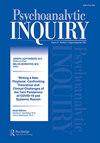At Home in Oneself: Self-States and the Treatment of Trauma
IF 0.5
4区 心理学
Q3 PSYCHOLOGY, PSYCHOANALYSIS
引用次数: 0
Abstract
ABSTRACTWhat does it mean to be at home in oneself? How is that sense created, lost, and restored? This paper explores psychoanalytic self-state theory and illustrates its application to the treatment of painful, dissociated states originating in childhood trauma, using a blend of psychoanalytic and somatic approaches.KEYWORDS: Traumaself-statesdissociationchildhoodpsychoanalysissomaticmind-body AcknowledgmentsThis paper was originally presented in September 2017 at the University of North Carolina Friday Center under the title, “Moving into Wholeness: Self-States and the Treatment of Trauma.” Conceived as a talk for early-career therapists, it is written in plain language and suitable for sharing with patients and family members.Dedicated with love to my brother, Vincent Paul Barkley, and to the memory of our sister, Dawn.Disclosure statementNo potential conflict of interest was reported by the author.Notes1 Psychic trauma refers to an experience which has an emotionally unbearable quality. Psychic trauma has two ingredients: a difficult or life threatening event, and the lack of sensitive, human support. Because overwhelming experiences at any age may precipitate dissociation, the self-state model can be applied to people of all ages who experience psychic trauma.2 Although this paper does not address the treatment of DID, self-state theory would be a most helpful model for understanding that personality organization. (See psychoanalytic writings of Brenner, Citation2001, Citation2004, Citation2009, Citation2014; Chefetz & Bromberg, Citation2004; Kluft, Citation2000. Other excellent references for treating DID include Fisher, Citation2017; Steele et al., Citation2016; van der Hart et al., Citation2006).Additional informationNotes on contributorsHeather CraigeHeather Craige, MSW, is a clinical social worker, psychoanalyst and somatic experiencing practitioner working in Raleigh, North Carolina. She graduated from the University of North Carolina-Duke Psychoanalytic Institute, now the Psychoanalytic Center of the Carolinas, serves as a training and supervising analyst.在自己的家里:自我状态和创伤的治疗
【摘要】自在是什么意思?这种感觉是如何产生、失去和恢复的?本文探讨了精神分析自我状态理论,并说明了其应用于治疗源自童年创伤的痛苦,分离状态,使用精神分析和躯体方法的混合。本文最初于2017年9月在北卡罗来纳大学星期五中心发表,标题为“进入整体性:自我状态和创伤的治疗”。它是为早期职业治疗师设计的演讲,用通俗易懂的语言编写,适合与患者和家庭成员分享。谨以爱献给我的弟弟,文森特·保罗·巴克利,并纪念我们的妹妹,道恩。披露声明作者未报告潜在的利益冲突。注1心理创伤是指在情感上无法忍受的经历。精神创伤有两种成分:一种是困难或威胁生命的事件,另一种是缺乏敏感的、人类的支持。因为任何年龄的压倒性经历都可能导致精神分裂,所以自我状态模型可以应用于所有经历过精神创伤的年龄的人虽然本文不涉及DID的治疗,但自我状态理论将是理解人格组织的最有帮助的模型。(参见Brenner的精神分析著作,Citation2001, Citation2004, Citation2009, Citation2014;Chefetz & Bromberg, Citation2004;Kluft Citation2000。其他治疗DID的优秀参考文献包括Fisher, Citation2017;Steele et al., Citation2016;van der Hart et al., Citation2006)。附加信息撰稿人海瑟·克雷格简介海瑟·克雷格,城市生活垃圾,是北卡罗来纳州罗利市的临床社会工作者、精神分析学家和躯体体验实践者。她毕业于北卡罗来纳大学杜克精神分析研究所,现为北卡罗来纳精神分析中心,担任培训和监督分析师。
本文章由计算机程序翻译,如有差异,请以英文原文为准。
求助全文
约1分钟内获得全文
求助全文
来源期刊

Psychoanalytic Inquiry
PSYCHOLOGY, PSYCHOANALYSIS-
CiteScore
1.00
自引率
33.30%
发文量
65
期刊介绍:
Now published five times a year, Psychoanalytic Inquiry (PI) retains distinction in the world of clinical publishing as a genuinely monographic journal. By dedicating each issue to a single topic, PI achieves a depth of coverage unique to the journal format; by virtue of the topical focus of each issue, it functions as a monograph series covering the most timely issues - theoretical, clinical, developmental , and institutional - before the field. Recent issues, focusing on Unconscious Communication, OCD, Movement and and Body Experience in Exploratory Therapy, Objct Relations, and Motivation, have found an appreciative readership among analysts, psychiatrists, clinical psychologists and a broad range of scholars in the humanities.
 求助内容:
求助内容: 应助结果提醒方式:
应助结果提醒方式:


